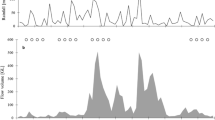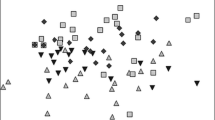Abstract
Great Lakes coastal wetlands are important habitats for turtles but few studies have looked at factors driving community structure in these systems. We evaluated the effects of wetland type, vegetation, and abiotic conditions on turtle communities for 56 wetlands in Lakes Huron, Michigan, and Superior with data collected during the summers of 2000–2008. Overall, 1,366 turtles representing seven species were captured using fyke nets. For the majority of species, catches were highest in drowned river mouth wetlands In addition, turtles tended to be more abundant in water lilies, submersed aquatic vegetation, and cattails compared to bulrush. We also found positive correlations between catches of four of the species as well as total turtle catch and turtle species richness with a human disturbance gradient. These correlations suggest that turtles may be able to utilize coastal wetland areas that are inhospitable to fish because of hypoxic conditions. Our results show the importance Great Lakes coastal wetlands to turtles, and stress the need for managers to take into account turtle populations when preparing conservation and restoration strategies.



Similar content being viewed by others
References
Albert DA (2003) Between land and lake: Michigan’s Great Lakes coastal wetlands. Michigan Natural Features Inventory, Michigan State University, Extension bulletin E-2902, East Lansing, p 96
Albert DA, Minc LD (2001) Abiotic and floristic characterization of Laurentian Great Lakes coastal wetlands. Verh Int Ver Theor Angew Limnol 27:3413–3419
Alexander MM (1943) Food habits of the common snapping turtle in Connecticut. J Wildl Manag 7:278–282
APHA (American Public Health Association) (1998) Standard methods for the evaluation of water and wastewater, 20th edn. American Public Health Association, Washington
Aresco MJ (2005) Ecological relationships of turtles in Northern Florida lakes: a study of omnivory and the structure of a lake food web. Dissertation, Florida State University
Becker GC (1983) Freshwater fishes of Wisconsin. University of Wisconsin Press, Wisconsin
Bishop CA, Gendron AD (1998) Reptiles and amphibians: shy and sensitive vertebrates of the Great Lakes basin and St Lawrence River. Environ Monit Assess 53:225–244. doi:10.1023/A:1005908204266
Bishop CA, Ng P, Pettit KE, Kennedy SW, Stegeman JJ, Norstrom RJ, Brooks RJ (1998) Environmental contamination and developmental abnormalities in eggs and hatchlings of the common snapping turtle (Chelydra serpentina serpentina) from the Great Lakes-St. Lawrence River basin (1989–1991). Environ Pollut 101:143–156
Bodie JR, Semlitsch RD (2000) Spatial and temporal use of floodplain habitats by lentic and lotic species of aquatic turtles. Oecol 122:138–146. doi:10.1007/PL00008830
Bond CE (1996) Bond’s biology of fishes. Brooks/Cole, Florence
Bouchard V (2007) Export of organic matter from a coastal freshwater wetland to Lake Erie: an extension of the outwelling hypothesis. Aquat Ecol 41:1–7. doi:10.1007/s10452-006-9044-4
Brazner JC, Beals EW (1997) Patterns in fish assemblages from coastal wetland and beach habitats in Green Bay, Lake Michigan: a multivariate analysis of abiotic and biotic forcing factors. Can J Fish Aquat Sci 54:1743–1761. doi:10.1139/cjfas-54-8-1743
Brazner JC, Tanner DK, Jansen DA, Lemke A (1998) Relative abundance and distribution of Ruffe (Gymnocephalus cernus) in a Lake Superior coastal wetland fish assemblage. J Gt Lakes Res 24:293–303. doi:10.1016/S0380-1330(98)70820-2
Burke VJ, Gibbons JW (1995) Terrestrial buffer zones and wetland conservation: a case study of freshwater turtles in a Carolina Bay. Conserv Biol 9:1365–1369
Burton TM, Uzarski DG (2009) Biodiversity in protected coastal wetlands along the west coast of Lake Huron. Aquat Ecosys Health Manag 12:63–76. doi:0.1080/14634980802715266
Burton TM, Stricker CA, Uzarski DG (2002) Effects of plant community composition and exposure to wave action on invertebrate habitat use of Lake Huron coastal wetlands. Lakes Reserv Res Manag 7:255–269. doi:10.1046/j.1440-1770.2002.00202
Burton TM, Uzarski DG, Genet JA (2004) Invertebrate habitat use in relation to fetch and plant zonation in northern Lake Huron coastal wetlands. Aquat Ecosys Health Manag 7:249–267. doi:10.1080/14634980490461614
Cardinale BJ, Brady VJ, Burton TM (1998) Changes in the abundance and diversity of coastal wetland fauna from the open water/macrophyte edge towards shore. Wetl Ecol Manag 6:59–68
Coffman WP, Ferrington LC (1996) Chironomidae. In: Merritt RW, Cummins KW (eds) An introduction to the aquatic insects of North America. Kendall/Hunt Publishing Company, Iowa
Comer AJ, Albert DA, Wells HA, Hart BL, Raab SB, Price DL, Kashian DM, Corner RA, Shuen RA (1995) Michigan’s native landscape, as interpreted from general land office surveys, 1816–1856. Michigan’s Natural Features Inventory Report to Water Division, U.S. EPA and Wildlife division. Michigan Department of Natural Resources Reserves, Lansing
Congdon JD, Gibbons JW (1996) Structure and dynamics of a turtle community over two decades. In: Cody ML, Smallwood JA (eds) Long-term studies of vertebrate communities. Academic Press, San Diego, pp 137–159
Congdon JD, Dunham AD, VanLobenSels RC (1994) Demographics of Common snapping Turtles (Chelydra serpentina): implications for conservation and management of long-lived organisms. Am Zool 34:397–408. doi:10.1093/icb/34.3.397
Cooper MJ, Uzarski DG, Burton TM (2007) Macroinvertebrate community composition in relation to anthropogenic disturbance, vegetation, and organic sediment depth in four drowned river mouth wetlands. Wetlands 27:894–903. doi:10.1672/0277-5212(2007)27[894:MCCIRT]2.0.CO;2
Cooper MJ, Rediske RR, Uzarski DG, Burton TM (2009) Sediment contamination and faunal communities in two subwatersheds of Mona Lake, Michigan. J Environ Qual 38:1255–1265
DeCatanzaro R, Chow-Fraser P (2010) Relationship of road density and marsh condition to turtle assemblage characteristics in the Laurentian Great Lakes. J Gt Lakes Res 36:357–365. doi:10.1016/j.jglr.2010.02.003
Ernst CH, Lovich JE, Barbour RW (1994) Turtles of the United States and Canada. Smithsonian Institution Press, Washington
Gathman JP, Burton TM, Armitage BH (1999) Coastal wetlands of the upper Great Lakes: distribution of invertebrate communities in response to environmental variation. In: Batzer DP, Rader RB, Wissinger SA (eds) Invertebrates in freshwater wetlands of North America. Wiley, New York, pp 949–994
Gibbs JP, Steen DA (2005) Trends in sex ratios of turtles in the United States: implications of road mortality. Conserv Biol 19:552–556. doi:10.1111/j.1523-1739.2005.000155
GLCWC (2008) Great Lakes Coastal Wetlands Monitoring Plan. Great Lakes Coastal Wetlands Consortium. www.glc.org/wetlands/final-report.html. Accessed March 2008
GLRCS (2005) Great Lakes Regional Collaboration Strategy to restore and protect the Great Lakes. www.glrc.us/strategy.html. Accessed March 2008
Gyekis KF (2006) Great Lakes coastal wetland fragmentation: edge effects on zooplankton, macroinvertebrate, and larval fish communities. Thesis, Grand Valley State University
Harding JH (1997) Amphibians and reptiles of the Great Lakes region. University of Michigan Press, Ann Arbor
Iverson JB (1982) Biomass in turtle populations: a neglected subject. Oecol 55:69–76. doi:10.1007/BF00386720
Jude DJ, Pappas J (1992) Fish utilization of Great Lakes coastal wetlands. J Gt Lakes Res 18:651–672. doi:10.1016/S0380-1330(92)71328-8
Jude DJ, Albert D, Uzarski DG, Brazner J (2005) Lake Michigan’s coastal wetlands: distribution, biological components with emphasis on fish, and threats. In: Edsall T, Munawar M (eds) State of Lake Michigan: ecology, health and management. Aquatic Ecosystem Health and Management Society, Burlington, pp 439–477
Keddy PA, Reznicek A (1986) Great Lakes vegetation dynamics: the role of fluctuating water levels and buried seeds. J Gt Lakes Res 12:25–36. doi:10.1016/S0380-1330(86)71697-3
Keough JR, Thompson TA, Guntenspergen GR, Wilcox DA (1999) Hydrogeomorphic factors and ecosystem responses in coastal wetlands of the Great Lakes. Wetlands 19:821–834. doi:10.1007/BF03161786
Klemens MW (2000) Turtle conservation. Smithsonian Institution Press, Washington
Krieger K, Klarer DM, Heath RT, Herdendorf CE (1992) Coastal wetlands of the Laurentian Great Lakes: current knowledge and research needs. J Gt Lakes Res 18:525–528
Lagler KF (1943) Food habits and economic relations of the turtles of Michigan with special reference to fish management. Am Midl Nat 29:257–312
LaMP (2008) Lake Michigan Lakewide Management Plan. U.S. Environmental Protection Agency. http://epa.gov/greatlakes/lamp/lm_2008/index.html
Lindeman PV (1996) Comparative life history of painted turtles (Chrysemys picta) in two habitats in the inland Pacific northwest. Copeia 1996:114–130
Lougheed VL, Crosbie B, Chow-Fraser P (2001) Primary determinants of macrophyte community structure in 62 marshes across the Great Lakes basin: latitude, land use & water quality effects. Can J Fish Aquat Sci 58:1603–1612. doi:10.1139/cjfas-58-8-1603
Marchand MN, Litvaitis JA, Maier TJ, DeGraaf RM (2002) Use of artificial nests to investigate predation on freshwater turtle nests. Wildl Soc Bull 30:1092–1098
Minc LD (1997) Great Lakes coastal wetlands: an overview of abiotic factors affecting their distribution, form, and species composition. Michigan Natural Features Inventory, Michigan State University Extension, East Lansing
Minns CK, Cairns VW, Randall RG, Moore JE (1994) An index of biotic integrity for fish assemblages in the littoral zone of Great Lakes areas of concern. Can J Fish Aquat Sci 51:1804–1822. doi:10.1139/f94-183
Nelson KM, Ruetz CR, Uzarski DG (2009) Colonisation by Dreissena of Great Lakes coastal ecosystems: how suitable are wetlands? Freshw Biol 54:2290–2299. doi:10.1111/j.1365-2427.2009.02265
Nürnberg GK (1995) The anoxic factor, a quantitative measure of anoxia and fish species richness in central Ontario lakes. Trans Am Fish Soc 124:677–686. doi:10.1577/1548-8659(1995)124<0677:TAFAQM>2.3.CO;2
Prince HH, Flegel CS (1995) Breeding avifauna of Lake Huron. In: Munawar M, Edsall T, Leach J (eds) The Lake Huron ecosystems: ecology, fisheries and management. SPB Academic Publishing, Amsterdam, pp 247–272
Prince HH, Padding PI, Knapton RW (1992) Waterfowl use of the Laurentian Great Lakes. J Gt Lakes Res 18:673–699. doi:10.1016/S0380-1330(92)71329-X
Ramsey P (1988) Critical values for Spearman’s rank order correlation. J Educ Stat 14:245–253. doi:10.3102/10769986014003245
Snodgrass JW, Bryan AL Jr, Lide RF, Smith GM (1996) Factors affecting the occurrence and structure of fish assemblages in isolated wetlands of the upper coastal plain, USA. Can J Fish Aquat Sci 53:443–454
Steen DA, Gibbs JP (2004) Effects of roads on the structure of freshwater turtle populations. Conserv Biol 18:1143–1148. doi:10.1111/j.1523-1739.2004.00240
Stephens PR, Weins JJ (2003) Explaining species richness from continents to communities: the time-for-speciation effect in Emydid turtles. Am Nat 161:112–128. doi:10.1086/345091
Tran SL, Moorhead DL, McKenna KC (2007) Habitat selection by native turtles in a Lake Erie wetland, USA. Am Midl Nat 158:16–28. doi:10.1674/0003-0031(2007)158[16:HSBNTI]2.0.CO;2
Uzarski DG, Burton TM, Cooper MJ, Ingram JW, Timmermans STA (2005) Fish habitat use within and across wetland classes in coastal wetlands of the five Great Lakes: development of a fish-based index of biotic integrity. J Gt Lakes Res 31:171–187
Uzarski DG, Burton TM, Kolar RE, Cooper MJ (2009) The ecological impacts of fragmentation and vegetation removal in Lake Huron coastal wetlands. Aquat Ecosyst Health Manag 12:45–62. doi:10.1080/14634980802690881
Vogt RC (1980) New methods for trapping aquatic turtles. Copeia 1980:368–371
Weeber RC, Vallianatos M (2000) The marsh monitoring program 1995–1999: monitoring Great Lakes wetlands and their amphibian and bird inhabitants. Bird Studies Canada, Port Rowan
Whillans TH (1982) Changes in marsh area along the Canadian shore of Lake Ontario. J Gt Lakes Res 8:570–577. doi:10.1016/S0380-1330(82)71994-X
Wilcox DA, Xie Y (2007) Predicting wetland plant community responses to proposed water-level regulation plans for Lake Ontario: GIS-based modeling. J Gt Lakes Res 33:751–773. doi:10.3394/0380-1330(2007)33[751:PWPCRT]2.0.CO;2
Acknowledgments
Funding for the various fish sampling projects came from the Great Lakes Commission, Great Lakes Protection Fund, Michigan Department of Environmental Quality, Michigan Department of Natural Resources, U.S. Environmental Protection Agency, and the U.S. Fish and Wildlife Service. Dr. Thomas Burton and Dr. Carl Ruetz III provided valuable guidance and insight on many of these projects. We thank members of the Uzarski, Burton, and Ruetz labs for assistance with fish sampling and chemical analyses.
Author information
Authors and Affiliations
Corresponding author
Rights and permissions
About this article
Cite this article
Wieten, A.C., Cooper, M.J., Parker, A.D. et al. Great Lakes coastal wetland habitat use by seven turtle species: influences of wetland type, vegetation, and abiotic conditions. Wetlands Ecol Manage 20, 47–58 (2012). https://doi.org/10.1007/s11273-011-9240-4
Received:
Accepted:
Published:
Issue Date:
DOI: https://doi.org/10.1007/s11273-011-9240-4




